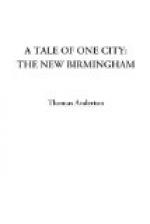With regard to the Festival of 1900—just closed as these lines are being written—I will say little. It has been financially successful, and perhaps that is the best that can be said of it. The programme, speaking generally, was a somewhat heavy and dull one, and the special new work, namely, Elgar’s “Dream of Gerontius,” was disappointing, in spite of its skilful construction, its splendid orchestration, and its conspicuous touches of character and originality. Mr. Coleridge Taylor’s “Song of Hiawatha” was the hit of the Festival, and its performance at Birmingham has hall—marked the young composer’s fresh, picturesque, and melodic music.
I might write a great deal more about the Birmingham Musical Festivals, but time and space forbid. I could, for instance, point out that it is becoming more and more difficult to maintain the prestige of our Festivals as time goes on. There is more competition now-a-days; there are more provincial musical gatherings; and there are now more high-class concerts than formerly. I think I could also show that some mistakes, of more or less importance, have been made, and are still perhaps being made in the management, Nevertheless, those who have most to do with the arrangements are not lacking in energy and enterprise, and in earnest endeavour to uphold the character and reputation of the Birmingham Musical Festivals.
XVII.
CONCLUSION.
There is now little or nothing further for me to say, save to put a tag to my small story, and make my little bow to my readers. Birmingham, like other modern enterprising centres, goes moving on “down the ringing grooves of change.” The city means to forge ahead, and will not permit anything to impede its progress. Scaffolding seems more conspicuous than ever, and before the ink is dry upon my page, more old buildings will be down and more new buildings will be up. Since I began these chapters (which have appeared in The Midland Counties Herald during the past months) some important, notable changes have taken place. For instance, the Birmingham Old Library in Union Street, associated with the names of many Birmingham worthies, has disappeared, and its site is occupied by the new City Arcades. That conspicuous landmark, Christ Church, with all its memories and curious belongings and characteristics, is now no longer to be seen. Old narrow streets are being widened, old buildings are bulging out, and large new buildings are being erected in all directions. The municipality have taken in hand some important housing schemes which may be advantageous to the working classes, and result in the erection of some of those new artisans’ dwellings which, so far, have not been conspicuously numerous. In the meantime local debts go on merrily, or I should say seriously, swelling. Ratepayers have to be squeezed to find the necessary funds for the increasing outgoings; but best-governed cities in the world must pay a price for their advantages and pre-eminence, and the citizens thank the gods that they have men who will devote thought and energy to laying out public money, and fervently hope that this may be done wisely and well.




